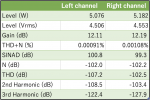daniboun
Major Contributor
We will revive the production of D100 configured as non-PFFB, since there are some people who still prefers non-PFFB configuration for TPA325x.
Sample feedback below.
View attachment 355844
My answer is put into perspective. There are two worlds, that of auditory perception and that of scientific interpretation. But there is something for all tastes and so much the better))
Now to stay concrete :
PFFB offers many benefits including lower output noise, improved THD+N performance, improved IMD performance, lower output impedance, frequency response less affected by load impedance, and suppression of nonlinearities of the LC filter.
All measurements of PFFB vs non PFFB are here

